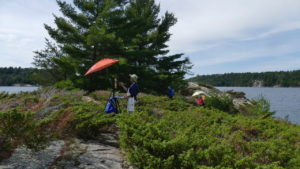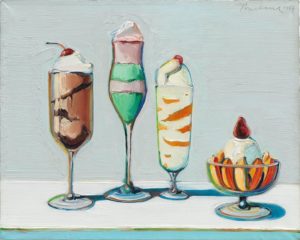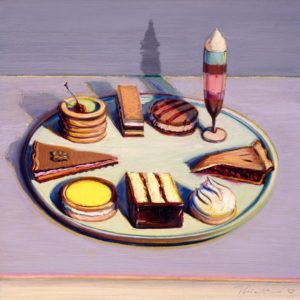Dear Artist,
In the good old days, students in art schools were provided with simple plaster forms. The sphere, pyramid and cube were the basics. Subjected to various types of light, simple drawing skills were tested and developed, the subtleties of light and shade, cast shadows, core areas and reflected light began to be understood. It was not a bad idea. Nowadays these objects often gather dust in forgotten cupboards. The avant-garde doesn’t demand them, the naive don’t think they need them.
In the beginning there was drawing. But drawing can be as awkward as stretching a coat-hanger around the edges of a form. While drawing can be beautiful and expressive in itself, the trouble with drawing is that it’s time consuming and it doesn’t tell you much. This is where an understanding of form comes in. It has to do with light, halftone and dark — patches of tone that when properly placed give a convincing idea of volume and shape. Here are a few ideas:
For many artists, form comes easier when it’s not too well drawn — or not drawn at all. Form is “found.” It’s found by looking at the work in progress (often with half closed eyes) and patching together swatches of tone that go together to describe what you want to see. At my easel I often think of the old sculptor’s advice: “Just chip away everything that doesn’t look like a horse.” Trying to draw out complex and repetitious forms such as piles of boulders tumbling down a Rocky Mountain slope can send you in for a lobotomy. Right now I’m using a broad, big-brush suggestion of the general area. For most of us, this is a better place to start. In a minute your eyes, working perhaps in collusion with your reference material, either at hand or canned, let you see what can be made out of this and that. Light, halftone, dark. Halftone, dark, light. Like magic, form materializes. There’s nary a line in sight. And when it can’t be realized, leave it, eat your bagels, come back later.
Best regards,
Robert
PS: “Lines as edges kill a sense of form.” (Paul Brandford) “There are forms that can only be seen when you are near a painting, others only appear when you are far away.” (Robert Henri) “Form, form, form.” (Joe Blodgett)
Esoterica: Look for a moment at the forms in your current work. If, in your opinion, more form would be desirable, try to “form them up” from the greatest of all reference — your mind’s eye. It’s a matter of finding out what you already know. Great things can happen when you know your spheres, pyramids and cubes. Then you can truly say: “I can wing it.”
This letter was originally published as “Form them up” on July 22, 2003.
Have you considered a Premium Artist Listing? With each letter, an artist is featured at the bottom of this page. The Premium Artist Listings are a means of connecting artist subscribers through their work. Proceeds from each listing contribute to the production of The Painter’s Keys.
“I haven’t the slightest idea what art is, but to be a painter is something of which you have to prove.” (
Featured Workshop
 The Killarney are of Ontario is in what is called the ‘near north’. The landscape is wild and rugged. Giant granite cliffs plunging deep into the glacial lakes. There are no roads leading to our painting locations. We travel by a large, sturdy pontoon boat. This is a self-catered retreat. You bring your own provisions and cook your own meals in our fully equip cabins at a northern camp. Our instructor, Keith Thirgood, has been teaching artists his own unique approach to painting for over 12 years. Learn how to find order in the chaos, control your colours and create paintings that work. Learn modern colour theory, values, shapes and lines, what makes for a good painting. This retreat is suitable for beginners wanting to learn to paint in a fun, outdoor location, as well as more experienced studio artists who want to try plein air, plus artists who are looking to loosen up and paint in a more post-impressionist style. To find out more and register, please visit www.wilsonstreetstudios.
The Killarney are of Ontario is in what is called the ‘near north’. The landscape is wild and rugged. Giant granite cliffs plunging deep into the glacial lakes. There are no roads leading to our painting locations. We travel by a large, sturdy pontoon boat. This is a self-catered retreat. You bring your own provisions and cook your own meals in our fully equip cabins at a northern camp. Our instructor, Keith Thirgood, has been teaching artists his own unique approach to painting for over 12 years. Learn how to find order in the chaos, control your colours and create paintings that work. Learn modern colour theory, values, shapes and lines, what makes for a good painting. This retreat is suitable for beginners wanting to learn to paint in a fun, outdoor location, as well as more experienced studio artists who want to try plein air, plus artists who are looking to loosen up and paint in a more post-impressionist style. To find out more and register, please visit www.wilsonstreetstudios.
Featured Artist
Candace studied at the Ecole des Beaux Arts in Angers, France but it is her travels in the deserts of Africa and Oman, Antarctica and the Arctic, and sacred sights of Machu Picchu and Petra that serve as her true place of learning. A desire to combine these experiences with a deeper understanding of her own spirituality has provided the underlying focus and inspiration for her paintings.








12 Comments
You are so right. These days we seem to think that everything is instant and that nothing should be evaluated and judged ( at least in school ) lest we injure the pride of a student. I do on-line teaching in the business management field and we take no prisoners; if the concepts are not properly understood. We expect people to make the effort, do the research and learn – ah what happened to that word “learn”. Yes art today is almost any “construction”. I do not know how curators choose their exhibits in some museums. Am I a forlorn classicist?
Thanks for telling the truth. The emperor has been running around bare-a$$ed far too long.
I can’t agree totally with this. I have been teaching drawing 1 for 30 years, in two universities. If you can’t draw well from observation, understand the application of perspective and the complexities of line, value, space, texture and color theory, you do not pass my class! Not only do you have to apply it, you need to observe and write about other artist’s as well!
I agree with your comment about injuring the pride of a student. The adults to whom I teach painting do not want to be bothered with drawing. Drawing is hard…teaching it is harder!
It’s quite possible, although a great challenge for a teacher, to keep pushing your students to set rigorous standards for themselves without ever uttering negative comments about their work. One of my best teachers in that regard is James Warwick Jones, an award-winning artist and a truly great teacher who lives in Hampton, Virginia. Always gentle, always positive, he nonetheless kept us all reaching for the best possible work we could do.
Beautifully said, Ann. Sometimes I think back to my math education as a kid, when we just memorized tables by rote. The lessons became something like the ability to ride a bike: you just “know it”. But then, the art is in the application, a bit like what Robert said here about the shapes. Building on that knowledge without fear or recrimination is essential to progress and satisfaction. There is a time and place for strict discipline as well, but the flow of creative impulse isn’t that place.
Things can be evaluated honestly, but kindly. When I do a critique, I point out what is working in the piece, then pick no more than one or two things that need to be addressed in the next work. I know talented people who gave up making art for years because of some negative or dismissive comment – frequently while in school. I avoid using the words “like” or “don’t like”, and point out a nice bit of color or a clear focal point. I have established that I am on the artist’s side, so then I might say that the work could be edited so that next time, you show the judge where to look, or that objects can be “set down” with a shadow. Too much criticism is daunting. Rigor does not need to be unkind.
I hope your not suggesting that art must have some redeeming value or that it must have some artist quality because art is really that what you hang on a wall as decoration!
Yes, the over-all physicality of a piece of art hanging on a wall is decoration, but it is made up of
form, colour, movement, et al – components that stimulate the viewer spiritually and intellectually. And that is its deeper worth.
Painting from the “mind’s eye” is easier said than done. Yet most landscape artists I know of work exactly as Robert describes. I think the trick is to practice over and over until you build a vocabulary that you can draw on from your imagination.
Yes, Art can be just decoration on a wall, ask any artist who’s suffering from the $99 Home Sense print phenomenon, But art is much more that that. Art is the manifestation of our deeper consciousness and our connection to the world of symbolic thought. Were the cave drawings, merely wall decoration or were they our early ancestors’ symbolic expression of the spiritual connections they felt to their world? They had no name for the “Otherness” they felt, so they painted it on the walls – not only to communicate their feelings to others, but to open themselves to “let it out”. That’s still how it is for most artists today. Hang us if you will, but we are telling you something about who you and we really are.
Another great article by Robert, whose wisdom and words resonate with me. As for my own creativity, having learned initially how to draw from various “forms” has definitely given me the ability to see form. Without having to learn to draw, my art would not be what it is. I am extremely thankful for having learned to “see” and draw as a fundamental tool of creating representational fine art.